Charts of the Week
Current economic trends from 15 to 19 June 2020: traffic of electronically tolled vehicles, electricity consumption, labour market, wages and other charts
Based on data on freight traffic and electricity consumption, we estimate that in the middle of June economic activity in Slovenia was still significantly lower than last year, but since mid-April the decline has been slowing in the year-on-year comparison. The number of unemployed persons, which was around one quarter higher in mid-June than before the outbreak of the epidemic, has also decreased slightly in the last few weeks. In April, the year-on-year growth of the average gross wage increased strongly. Growth was influenced by the methodology regulating how employers report wages, in connection with the intervention measures for preserving jobs and the payment of allowances. As a result of measures to contain the epidemic, activity declined significantly again in all segments of construction. The current account surplus rose again, to more than 7% of estimated GDP.
Traffic of electronically tolled vehicles on Slovenian motorways, June 2020
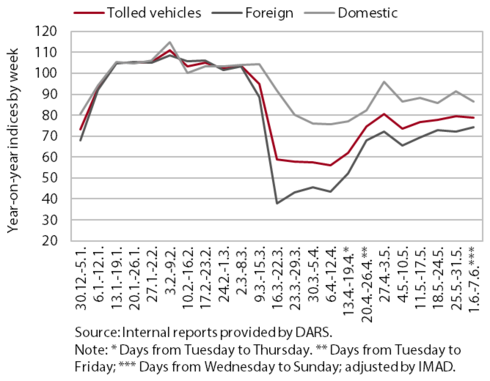
Freight traffic on Slovenian motorways has remained approximately one fifth below last year’s level in the weeks since mid-April. After a decline of more than 40% in the first weeks following the declaration of the epidemic and an improvement in mid-April, it was thus still significantly lower year on year in the second week of June. The distance travelled by domestic and foreign trucks declined by around 15% and one quarter respectively. Traffic by foreign trucks has otherwise increased significantly compared with the lowest values at the end of March, as a result of EU measures for the free flow of goods and the general relaxation of measures in some countries.
Electricity consumption, June 2020
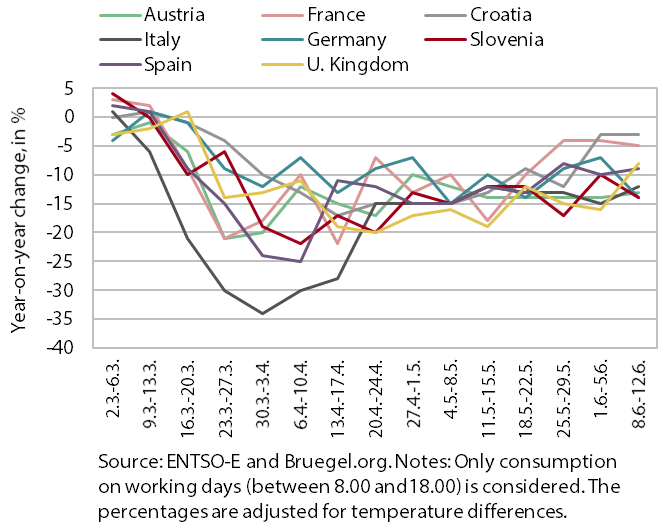
The year-on-year decline in weekly electricity consumption remained close to the May average in the second week of June. Electricity consumption, which is one of the indicators of economic activity, was 14% lower year on year in Slovenia in the second week of June, which is similar to the average in May. In Slovenia’s main trading partners, the year-on-year fall in consumption relative to the weeks in May decreased the most in France and Croatia. In Germany, after decreasing for two consecutive weeks, the year-on-year fall in consumption deepened in the second week of June, to 14%, which is somewhat more than the average weekly decline in May (12%).
Labour market, April–June 2020
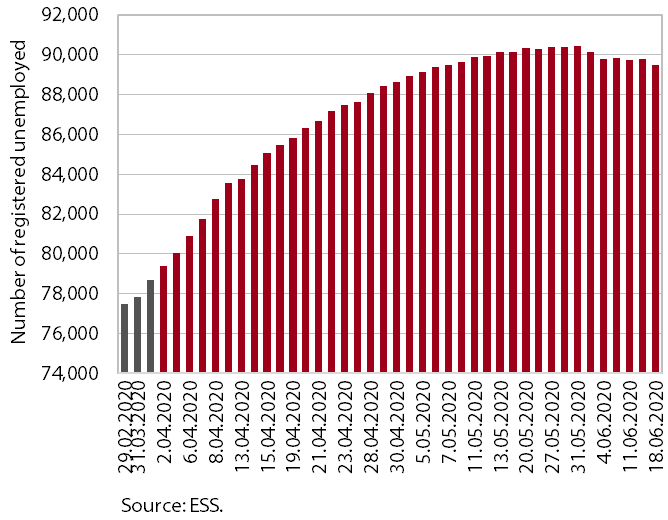
The number of unemployed persons has decreased in the last few weeks. After it was still higher year on year in the first three months, employment declined year on year in April (by 1%), the most in accommodation and food service activities and administrative and support service activities (by around 10%). Unemployment, which had increased to 90,415 persons by the end of May, dropped by 1% to 89,480 persons by 18 June according to ESS unofficial (daily) data. The easing of labour market conditions is related to the lifting of stringent containment measures in Slovenia and neighbouring countries and the adoption of the third legislative package of measures to mitigate the economic impact of the crisis.
Wages, April 2020
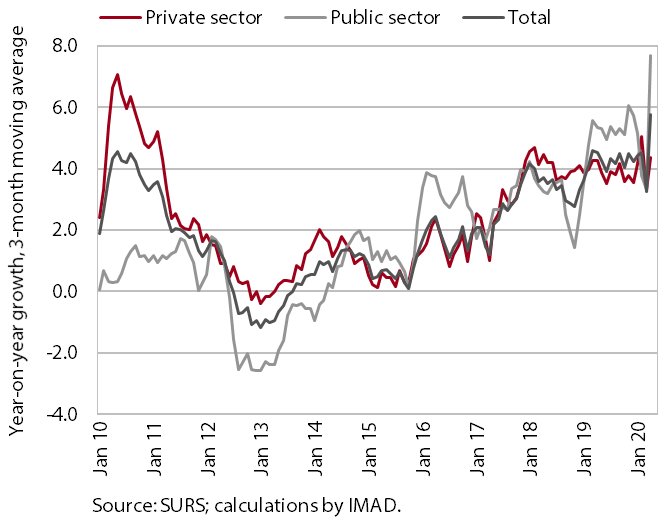
Year-on-year growth in the average gross wage increased notably in April (11.9%), mainly as a consequence of the methodology for reporting wages for workers on temporary layoff. In the private sector, the pronounced year-on-year growth of wages (8.4%) was significantly influenced by the methodology, according to which employers report the number of persons who receive wages and only the amount of wages funded from their own resources (and not wage compensation paid by the government). As many employed persons were temporarily laid off, the amount of wages paid from employers’ resources decreased significantly in April compared with the previous month. The number of employed persons who received these wages declined even more, which affected growth in the average gross wage. In the public sector, the methodological effect of temporary layoffs was significantly smaller. The stronger wage growth (16.3%) reflected the payment of allowances for harmful working conditions and additional workloads and the payment of the bonus for work in risky conditions (according to the collective agreement).
Construction, April 2020
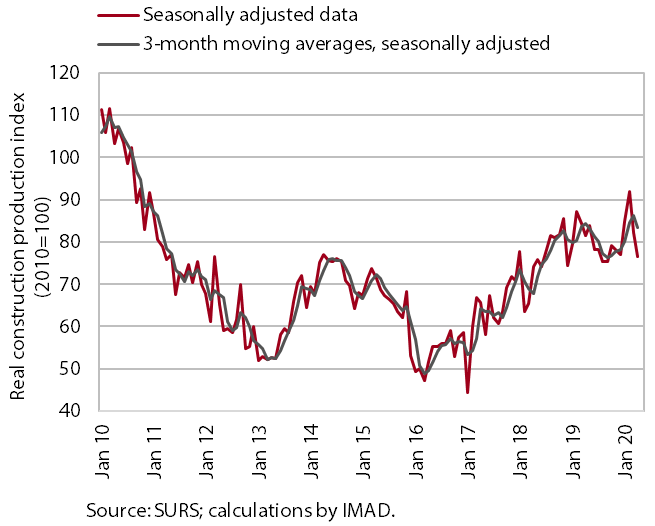
After strengthening at the beginning of the year, construction activity declined in all segments in March and April due to the outbreak of the new coronavirus. Relative to February, the last month before the outbreak of the epidemic, activity declined by 16.8%, the most in the construction of non-residential buildings (-27.9%), followed by the construction of civil-engineering works (-17.2%) and residential buildings (-5.1%). Some other data (VAT returns) indicate an even larger drop in activity, by around one third.
The stock of contracts remained high in April, higher than one year ago. However, these data are provisional and may change (for March they changed by 9%). The number of construction permits was significantly lower year on year in May, as was confidence in construction, which is a sign of a considerable deterioration in construction activity.
Current account, April 2020
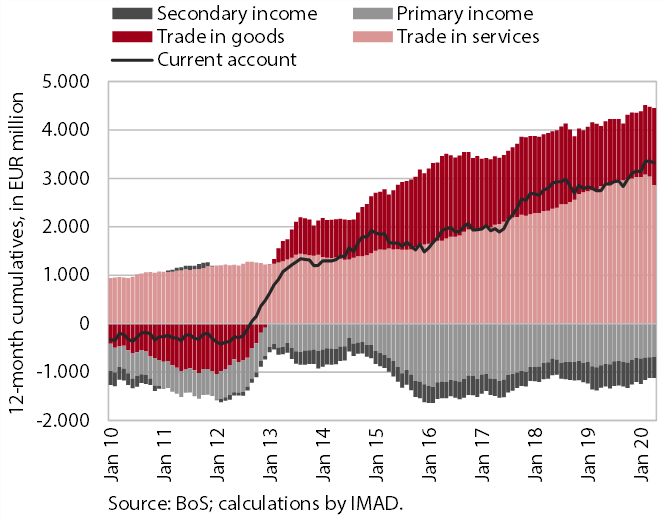
The current account surplus remained high in the last 12 months to April (EUR 3.3 billion, which is more than 7% of estimated GDP). The higher surplus compared with the same period of last year was mainly due to the surplus in trade in goods. As a result of the adoption of containment measures, goods trade otherwise dropped noticeably in April, but net exports increased. The twelve-month surplus in services trade was, despite a pronounced fall in April, also higher year on year (mainly due tu a higher surplus in trade in telecommunication, computer and information services). Trade in travel services almost came to a halt in April, while trade in transport services was a fifth lower year on year. Net outflows of primary income dropped further, mostly owing to lower net payments of income on equity. Net outflows of secondary income declined mainly due to lower payments into the EU budget.
Slovenian industrial producer prices, May 2020
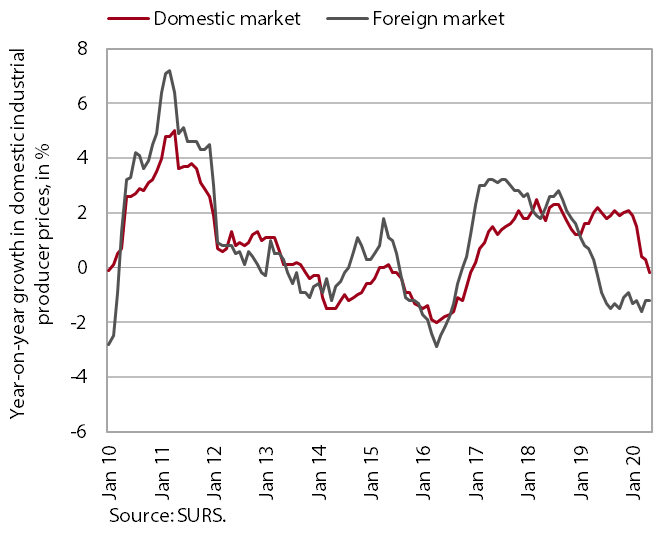
The year-on-year decline in Slovenian industrial producer prices increased slightly in May (to 0.7%). This was mainly due to lower prices on the domestic market, which were down year on year for the first time since 2016. Year-on-year growth in prices of consumer goods in May was lower than in previous months. Prices of durable goods fell slightly year on year due to lower demand at the outbreak of the epidemic, while growth in non-durable goods prices eased somewhat but remained relatively high (at 2.9%). Commodity and energy prices remained down year on year. The decline in producer prices on foreign markets remained just above 1%.
